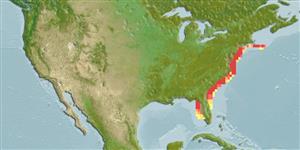Classification / Names
Common names from other countries
Main reference
Size / Weight / Age
Max length : 40.0 cm SL male/unsexed; (Ref. 7251); common length : 27.5 cm SL male/unsexed; (Ref. 188); max. published weight: 200.00 g (Ref. 7251); max. reported age: 8 years (Ref. 12193)
Environment
Marine; freshwater; brackish; pelagic-neritic; anadromous (Ref. 51243); depth range 5 - 55 m (Ref. 5951)
Climate / Range
Subtropical, preferred 12°C (Ref. 107945); 41°N - 25°N, 84°W - 60°W (Ref. 188)
Distribution
Short description
Dorsal
spines
(total): 0;
Dorsal
soft rays
(total): 15-20;
Anal
spines: 0;
Anal
soft rays: 15 - 21;
Vertebrae: 47 - 53. Moderately compressed, belly with distinct keel of scutes. Upper jaw with a distinct notch; lower jaw rising steeply within mouth; minute teeth present at front of jaws (disappearing with age). Lower gill rakers 41 to 52 (fewer in fishes under 10 cm standard length), slender. Back dark blue, sometimes bluish-grey; a dark spot on shoulder (Ref. 188). Peritoneum black (Ref. 7251). Branchiostegal rays 7 (Ref. 4639).
IUCN Red List Status (Ref. 115185)
Threat to humans
Harmless
Human uses
Fisheries: commercial
Tools
Special reports
Download XML
Internet sources
Estimates of some properties based on models
Phylogenetic diversity index
PD50 = 0.5000 many relatives (e.g. carps) 0.5 - 2.0 few relatives (e.g. lungfishes)
Trophic Level
3.8 ±0.3 se; Based on diet studies.
Resilience
Medium, minimum population doubling time 1.4 - 4.4 years (K=0.18; tm=4; Fec=45,800)
Vulnerability
Moderate to high vulnerability (51 of 100)
Price category
